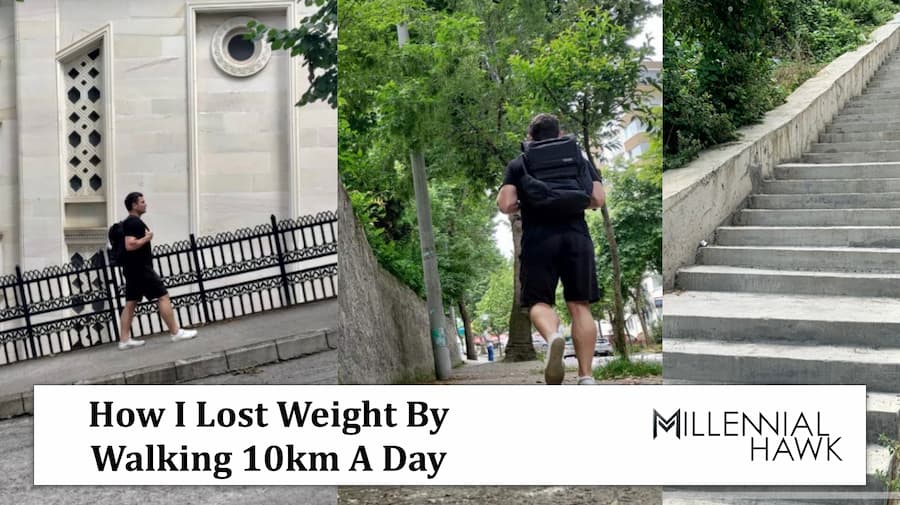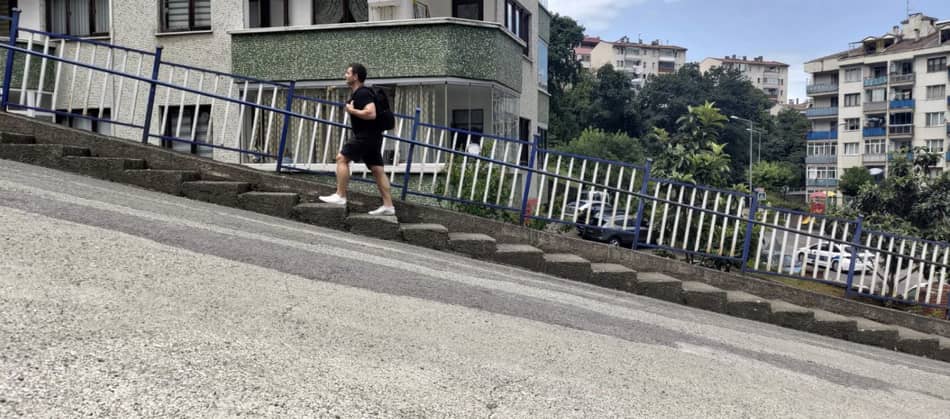Walking 10km a day refers to the daily practice of walking a distance of 10 kilometers, which is approximately 6.21 miles, as a form of exercise or physical activity. Whether “walking 10km a day is too much” depends on your mobility, fitness levels, and goals. It can be challenging for people with obesity, those who have had surgery or heart problems, or individuals who are used to shorter distances. However, it’s achievable and a great goal for healthy but sedentary adults and adolescents.
Recently I came back from holidays and together with my wife we were walking over 10km a day with no gym and no dieting. After we came back, we both continued this habit for the next 30 days and managed to lose a good amount of weight.
Walking 10 kilometers (6.2 miles) a day can burn around 451 to 601 calories, making it an effective way to support weight loss and improve cardiovascular health. It’s accessible to most people and particularly beneficial when maintaining a steady pace at 60-70% of your maximum heart rate, where fat burn is optimized and conversation is possible.
To get started, I recommend getting a pair of running shoes, using outdoor gyms, and choosing stairs to make it more challenging. If walking 10 km a day isn’t enough, there are many ways to progress, such as adding resistance training, using a weighted vest, or ultimately trying longer distances like walking 10 miles a day.

Why did I start to walk 10km a day?
I started walking 10km a day because it led to significant weight loss for both me and my wife without any gym equipment—just consistent walking around the city. Over the last two months, I lost 15 pounds and my wife lost 12 pounds, simply by walking 10km a day (10km was the average). We had no access to a gym, no resistance bands, and we didn’t take our yoga mat. It was just walking around the city. On some days, we took it easy and walked less, whereas on other days we walked more (the record day was 28,321 steps, which is around 21.5km).
I walk 10 kilometers a day to lose weight, not just because it’s convenient, but also because it helps clear my mind when tackling tough tasks, and I can do it anytime, even in my business suit.
How long does it take to walk 10 kilometers?
Walking 10 kilometers would take approximately 4 hours at a pace of 2.5 mph, around 1 hour and 46 minutes at a pace of 3.5 mph, and about 1 hour and 33 minutes at a pace of 4.0 mph. These times are based on continuous walking without breaks. The duration varies depending on individual walking speeds and the number of breaks taken.
How many calories does walking 10km a day burn?
Walking 10 kilometers a day can torch around 400-600 calories, with the actual number influenced by things like hills, your weight, and how fast you stroll. If you keep up this pace and walk 10k (that’s 6.2 miles) every day for a whole week, you could shed between 3,150 to 4,207 calories, which translates to losing roughly one pound of fat.
While there are more intense workouts like running, jogging, and HIIT that burn more calories than walking, I feel better walking this distance. After a high-intensity workout, I often find myself feeling more exhausted, which sometimes leads to eating more, rather than less. Walking 10km a day was a good idea because I didn’t feel like I was exercising, so I managed to keep my food intake the same as before.
How many calories does walking 10km a day burn compared to jogging the same distance?
Walking 10 kilometers a day burns around 400-600 calories for the average person. However, if you’re jogging that same distance, especially when you weigh about 190 pounds and maintain an average speed of 5 mph, you can torch about 786 calories. If you happen to be a 220-pound individual, you’ll burn approximately 912 calories while jogging. This difference is because jogging is more intense and demands more energy than walking.
How many calories does walking 10km a day burn if done at a brisk pace?
At a brisk pace of 3.5 mph, a 200-pound person burns approximately 410 calories per hour, resulting in about 730 calories burned throughout walking 10km. At a very brisk pace of 4.0 mph, the same person burns around 477 calories per hour, totaling about 850 calories for 10km. Therefore, the calorie burn for walking 10km ranges from 730 to 850 calories, depending on the walking speed.
What are the health benefits of walking 10km a day?
Walking 10km a day reduces heart disease risk, support healthy aging, improve cardiovascular and muscular endurance, aid in weight management, enhance metabolic health, strengthen bones, and offer psychological and social benefits.
- Reduced Heart Disease Risk: A 1988 study by Rippe et al. from the University of Massachusetts Medical School, published in JAMA, indicates that consistent walking can lower the likelihood of developing coronary heart disease by improving cardiovascular health.
- Healthy Aging: A 2023 study by Zoltan Ungvari from the University of Oklahoma Health Sciences Center, featured in Geroscience, suggests that walking can mitigate the severity of age-related diseases, enhance cognitive function, and contribute to longer life expectancy.
- Enhanced Cardiovascular and Muscular Endurance: In a 1997 study titled “Walking to Health” by Morris and Hardman, published in Sports Medicine, it was found that walking can enhance cardiovascular capacity and muscle strength. These benefits are essential for everyday tasks and handling more intense physical challenges.
- Weight Control: The same study by Morris and Hardman highlights that walking expends energy, which can help with long-term weight management and control, an essential factor in maintaining a healthy weight.
- Improved Metabolic Health: Regular walking is associated with better management of high-density lipoproteins and insulin/glucose levels, leading to improved metabolic health outcomes.
- Increased Bone Strength: Walking, being a weight-bearing activity, is linked to stronger bones, reducing the risk of osteoporosis and related complications, as discussed in various health studies.
- Psychological and Social Benefits: While not as extensively researched, the psychological and social aspects of walking are acknowledged for their therapeutic qualities, enhancing mental health and fostering social bonds.
Walking 10km a day is healthy. Dozens of studies show the benefits of daily walking on cholesterol, hypertension, diabetes, and other chronic disease events. Plus, walking is simple, free, and easy to be active.
Different durations of daily walking were associated with decreased mortality for younger-elderly men with or without critical diseases, independent of sociodemographic and lifestyle factors, BMI, medical status, disease history, and functional capacity.
What are the health risks of walking 10km a day?
Here’s a list of potential health risks associated with walking 10km a day.
- Overuse injuries (e.g., shin splints, stress fractures) due to increased intensity without proper conditioning.
- Joint pain or worsening of arthritis from walking without adequate footwear or on hard surfaces.
- Cardiovascular strain for individuals with pre-existing heart conditions.
- Respiratory issues from walking in areas with poor air quality.
- Heat-related illnesses or hypothermia from walking in extreme weather conditions without proper precautions.
- Excessive fatigue and discouragement for individuals with severe obesity due to the high relative intensity of walking.
- The possibility of not observing any dose-response effect of walking exercise on weight loss over diet alone, as found by Brill et al. (2002) from the University of Miami.
What are the signs of overtraining from walking 10km a day?
Signs of overtraining from walking 10km a day include persistent fatigue, decreased performance, and increased risk of injury, as indicated in a 1997 study by Eva Mattsson from Karolinska Institute, which found that excessive walking can be too exhausting for obese women.
A 2002 study by Janet Bond Brill from the University of Miami suggests that walking volume does not necessarily lead to weight loss over diet alone, implying that more isn’t always better. Walking intensity, rather than duration, is crucial for cardiorespiratory fitness, suggesting that overtraining can occur with excessive duration at insufficient intensities.
Who should start walking 10km a day?
Individuals aiming for cardiovascular health, weight management, and overall wellness should consider walking 10km a day, as suggested by J.M. Rippe’s study at the University of Massachusetts Medical School, which links moderate-intensity exercise like walking to reduced heart disease risk and weight loss. On the other hand, people with certain health conditions such as advanced osteoarthritis, severe heart disease, uncontrolled hypertension, or recent surgery may need to avoid starting a high-intensity walking program like walking 10km a day.
How to start walking 10km to lose weight
Here’s how to start walking 10-kilometer-a-day to lose weight.
- Buy supportive shoes.
- Schedule daily walks.
- Establish a post-meal walking routine.
- Increase walking challenges.
- Utilize stairs regularly.
- Prefer hilly paths.
- Carry extra weight.
- Stretch regularly.
- Embrace rest days.
- Stay hydrated.
- Use audio entertainment.
1. Buy supportive shoes
Buying supportive shoes means selecting footwear specifically designed to provide proper arch support, cushioning, and stability needed for walking 10 kilometers a day. The purpose of investing in supportive shoes for walking 6.21 miles a day is to ensure foot comfort, reduce injury risk, and improve walking performance by providing the right support where it’s needed most.
I’m not suggesting you drop $200 on a brand-new pair of sneakers, but make sure you have good support to reduce the risk of foot and ankle injuries. When you purchase them, use them exclusively for walking, and think about replacing your walking shoes roughly every 48 to 81 days (around 300-500 miles) if you’re covering 10km daily. Believe me, having a quality pair not only enhances comfort during those long walks but can also improve your walking posture and efficiency.
While I’m not a shoe expert, I do know from experience that shedding weight by walking 10km a day won’t happen overnight. So, my suggestion is to grab yourself a pair of comfy shoes.
For walking 10km a day, your best bet is a pair of running shoes with thicker soles that offer extra support and cushioning. While these shoes are super comfy for those long walks, it’s no secret that they’re not winning any style awards. I own a pair of Hoka One One shoes that look horrible and don’t match any of my clothes.
However, they are the most comfortable walking and running shoes I’ve ever worn, so I wear them. The worst shoes for walking 10km a day are boots with high heels or flip-flops. While these may look stylish for a night out or a beach break, they won’t work for your daily weight loss walk. Walking long distances in flip-flops can make my legs tired and my ankles swell. On the flip side, if I wear boots for extended periods, I often get blisters and experience toe pain.
2. Schedule daily walks
Scheduling daily walks means setting aside a specific time each day to walk 10km, creating a routine that fosters consistency and commitment. The purpose of this is to establish a regular exercise habit that can lead to sustained weight loss, improved cardiovascular health, and enhanced mental well-being. The pros include increased calorie burn, strengthened muscles, and the potential for a clearer mind due to the meditative nature of walking. However, the cons may involve the time commitment required and the potential for overuse injuries if proper rest and recovery are not taken into account.
3. Establish a post-meal walking routine
Establishing a post-meal walking routine involves taking a walk after each meal, aiming for a total daily distance of 10 kilometers. A 2023 meta-analysis by Tobias Engeroff and colleagues at Goethe-University Frankfurt found that walking immediately after meals, particularly dinner, can significantly reduce postprandial glucose spikes, making it an effective strategy for managing blood sugar levels. The purpose of this “after supper walk” is to utilize the body’s natural metabolic state to more efficiently process glucose intake, which is especially beneficial for individuals with impaired glucose tolerance or type 2 diabetes.
The benefits of walking 10km a day after a meal include improved metabolic health, a structured approach to incorporating physical activity into your day, and the potential for weight loss and improved cardiovascular health. However, the cons may involve the challenge of finding time to walk after every meal, potential discomfort if walking too soon after eating, and the need for consistency regardless of weather or schedule changes.
4. Increase walking challenges
Increasing walking challenges when aiming to walk 10km a day involves progressively adding difficulty to your walking routine to enhance physical fitness and prevent plateauing. In general, walking 10km a day is enough exercise, as long as you incorporate additional resistance training.
According to the American College of Sports Medicine (ACSM), you should aim for at least two days of strength training per week. But if you’re like me and enjoy outdoor workouts, consider looking for places with outdoor gyms to incorporate into your walking routine, as shown in this photo.

In most modern cities, there are outdoor gyms or fitness parks with free access to equipment. These outdoor gyms typically feature a range of machines for working on your legs, arms, shoulders, and abs. While indoor gyms offer more machine variety, exercising in the fresh air outdoors can be a great option if you can bring all the equipment outside.
5. Utilize stairs regularly
Using stairs regularly means incorporating stair climbing into your walking 10k a day routine to increase the intensity of the workout, which can enhance cardiovascular health and build lower body strength. I find that walking up the stairs is much better than walking on a flat surface because you can burn 0.17 to 0.20 calories for every step that you take. Walking up the stairs elevates the heat rate more and gets you out of breath, even if you walk slowly.

According to my Fitbit, walking up the stairs gets my heart rate to zones 3 and 4, whereas walking on a flat surface usually keeps me in zones 1 and 2. Additionally, climbing the stairs also demands more muscle activation in your quadriceps, glutes, and calves.
The number of stairs you need for a good workout depends on your mobility and fitness level. For instance, I can climb stairs for 10 minutes without a break, while my wife starts huffing and puffing after just a minute or two. My point is that walking up 6.2 miles of stairs in a day gives your butt more of a workout than walking on a flat surface.
However, if you’re thinking of walking 10km a day, I wouldn’t suggest sticking to a single staircase for your workout. Trust me, I’ve given that a shot a few times, and it can get pretty darn tedious. It’s way more enjoyable to pick a route that mixes it up a bit—throw in some stairs, tackle a few hills, hit some flat ground, and maybe even some downhill stairs to make your walk more fun and interesting.
6. Use hilly paths
Using hilly paths means including routes with inclines and declines in your daily 10km walk to increase the intensity of the workout and boost calorie burn. Walking up a hill is very similar to walking up the stairs. It helps to engage different muscle groups, elevates the heart rate, and increases the metabolic rate.

Incline walking can be quite therapeutic, similar to strolling in nature. According to online calorie calculators, walking uphill with a 3% incline can burn double the calories compared to walking on a flat surface. Dr. Derek Haight, a senior biomechanics researcher at Nike, suggests that uphill walking might be a suitable exercise for individuals dealing with obesity, as it puts less strain on their joints when done at a slower pace on an incline of around 6%. So, walking 10 kilometers a day uphill is a beneficial approach for weight loss, allowing you to amp up the intensity without needing to pick up the pace and be gentler on your joints.
Of course, walking uphill every day can be quite strenuous on the body and requires a certain level of fitness. I remember when I first started uphill walking, I could barely walk the next day – my calves were as hard as rocks, and my lower back ached. If you’re a beginner, I wouldn’t recommend diving straight into uphill walking. Instead, gradually build up your muscle endurance and introduce hills maybe every two days.
I understand that not everyone has the luxury of walking 10km a day on uphill terrain. If you live in a hilly place like San Francisco or Seattle, you’re in luck. However, if you reside in flatter areas like Florida or Louisiana, you might not have as many hills to choose from. In that case, consider using a treadmill at the gym, as most gyms offer this option.
7. Carry extra weight
Carrying extra weight means adding more resistance to your walk, like wearing a weighted vest or carrying a backpack, to increase the intensity of your 10km daily walking routine, which can help burn more calories and build strength.
I wore a 20-pound weighted vest during my 10km walks for 3 weeks. At first, it was tough, especially when tackling uphill stretches. I sweated more, and my legs felt as heavy as rocks.
Over time, as my body got accustomed to it, I noticed that I can walk longer without getting so out of breath when climbing stairs. Weighted vests, also known as hypergravity training gear, are great for walking because they provide added resistance, which boosts calorie burning. They also help increase your peak running speed, enhance leg stiffness for greater force generation, and improve overall running efficiency. According to my Fitbit, you burn an additional 2 calories for every extra pound you wear.
8. Stretch regularly
Incorporate stretching exercises into your daily routine before and after your 10km walks. This practice improves flexibility, prevents muscle stiffness, and lowers the risk of injury, allowing you to enjoy your long walks and maintain your well-being. Starting a full-body stretching routine when you begin long-distance walking is one of the best things you can do. It loosens up your muscles and ensures you wake up the next morning feeling refreshed, not tired.
When it comes to the age-old question of whether it’s better to stretch before or after a walk, my suggestion is to do both. Stretching before walking is beneficial because it increases your range of motion and helps prevent injuries. Stretching after your walk is equally important as it reduces muscle tension and minimizes soreness. You don’t need to be a stretching pro; just dedicate 5 minutes before and 10-15 minutes after your walk.
Before you start your walk, I recommend doing some dynamic stretches that activate your sympathetic nervous system and get you ready for your workout. Around halfway through your walk, take a break to stretch your calves and quads. This will help you feel more limber, especially if you’re tackling uphill terrain. After completing your 10km walk for the day, spend some extra time doing a variety of stretches for your whole body to reap the full benefits.
9. Embrace rest days
Embracing rest days means that as part of your routine of walking 10km a day, it’s essential to include days when you give your body a break from this intense exercise. I recommend starting with 5 days and gradually increasing to 7. If you can’t manage 6.2 miles, aim for 3-4 miles instead. These rest days allow your muscles to recover, reduce the risk of overuse injuries, and help prevent burnout. They are a crucial component of a sustainable and healthy walking routine.
10. Stay Hydrated
Staying hydrated means that while walking 10km a day, it’s important to drink enough water to maintain proper fluid balance in your body. One of the worst things that can happen during your walks is not getting enough water. As you walk, your body can quickly become dehydrated, leading to a loss of energy, feelings of lethargy, and the onset of muscle cramps.
In the first few days, I completely forgot to drink water (rookie mistake). By the end of the day, I felt weak and had tight muscles. Once I got my water intake organized, I immediately started feeling better. I was drinking around 500ml of water during a 90-minute brisk walk. However, when the outdoor temperature was 70 degrees or higher, I was drinking at least one liter of water.
According to the CDC, adults should aim to drink about 8 cups (64 ounces) of water daily to stay properly hydrated. On average, US adults only consume about 44 ounces of plain water daily, falling short of the recommended 64 ounces. However, it’s important to remember that individual hydration needs can vary based on factors like age, activity level, and climate. When you’re walking 10km a day, it’s a good idea to drink water throughout the walk to stay hydrated, especially in warmer weather.
11. Use audio entertainment
Use audio entertainment like listening to music, podcasts, or audiobooks while walking 10km a day, which typically takes 90 to 120 minutes. Doing the same route every day can become quite boring, so I suggest keeping things interesting by enjoying podcasts, audiobooks, music, or other forms of entertainment on your phone.
I never go outside for a walk without some music or a podcast playing. I’ve got over 20 different playlists I use, depending on my mood and the time of day. Honestly, I’m pretty hooked on music because it instantly boosts my energy and lifts my spirits. To be honest, I don’t think I could manage a 10km walk every day without my tunes.
For me, it’s like my daily dose of caffeine. It has a real workout-boosting effect, helping me walk farther, longer, and more often. Dr. Peter C. Terry, a Psychology professor at the University of Southern Queensland, even backs this up, saying that “listening to music is linked to feeling more positive, improved physical performance, reduced perceived effort, and better oxygen use.”
In a 2009 study published in the Journal of Sport and Exercise Psychology by Costas I. Karageorghis and his team, they found that motivational music had a significant impact, increasing endurance compared to a no-music control.
Which music should you choose? For my morning walks, I enjoy a mix of classical, pop, and uplifting film scores. During my afternoon walks when I need an energy boost, I prefer house, techno, and rock tunes. In the evening, I like to unwind with my favorite classic piano and cello instrumental tracks.”
What kind of results can you expect from walking 10km a day?
Walking 10km a day can result in a gradual weight loss of 1-2 pounds (approximately 0.45-0.9 kilograms) per week when combined with calorie control and regular resistance training. Calorie restriction is essential for tapping into stored fat for energy, while resistance training helps maintain lean muscle mass. Incorporating resistance training in your routine over the last 30 days is a positive step towards preventing muscle loss during weight loss efforts.
Can you lose weight by walking 10km a day without changing diet?
Yes, you can lose weight by walking 10km a day without changing your diet, as long as you create a calorie deficit through exercise. I started walking 10km a day during my holidays. I was eating the same amount of food that I normally eat. However, the weight started to go down and I didn’t feel hungry (which is why I’m so excited about this process).
Compared to high-intensity workouts like T25 or P90x, walking 10km a day had a different effect on my appetite. With intense workouts, my food intake increased significantly, leading to cravings for sweets and high-calorie foods. However, when I walked 10km a day, I only had coffee and water, and I didn’t experience cravings for sweets or chocolates, possibly due to caffeine’s appetite-suppressing effect.
What could hinder weight loss when walking 10km a day?
Unrealistic weight loss expectations and impulsive overeating are common factors that may hinder weight loss when walking 10km a day. It’s important to recognize that weight loss takes time and consistency, and being mindful of your dietary habits can significantly impact your progress.
Is walking 10 kilometers a day considered a form of exercise?
Yes, walking 10 kilometers a day, which equals about 14,080 steps, falls within the range of moderate-to-vigorous physical activity recommended by the Physical Activity Guidelines Advisory Committee (PAGAC). It’s a great way to stay active and reap the health benefits associated with regular exercise.
Is it better to walk 10km outdoors or on a treadmill?
Taking a 10-kilometer walk outdoors offers a more varied terrain and fresh air, enhancing the overall experience. On the other hand, treadmill walking allows you to adjust your pace and can also be an effective form of exercise. So, choose the option that best suits your preferences and circumstances.
Is it better to walk 10km a day or 10 miles a day?
Walking 10 kilometers a day covers approximately 6.2 miles, and it’s a recommended daily goal for better health. Walking 10 miles a day would be more than double that distance and could be challenging for most people to sustain daily. So, walking 10 kilometers (6.2 miles) a day is a practical and beneficial choice for most individuals.
Can I split the 10km walk into multiple sessions throughout the day?
Yes, you can split the 10km walk into multiple sessions throughout the day for the same health benefits.
